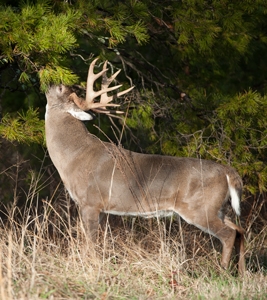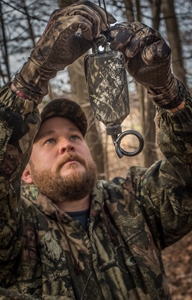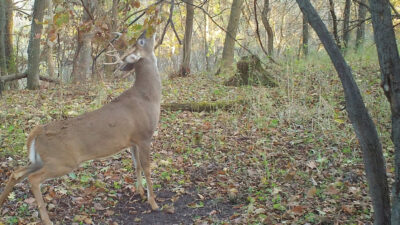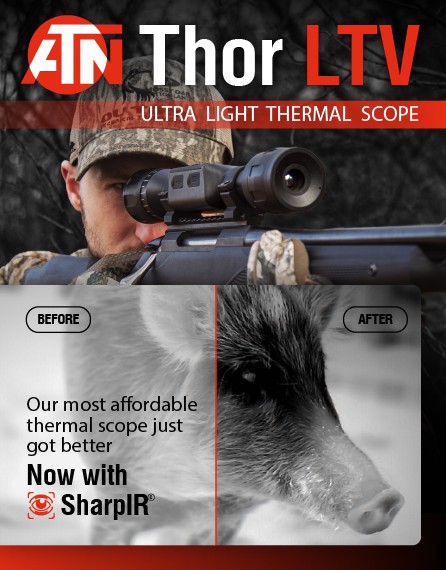The big bodied ten-pointer vigorously pawed at the soil beneath my “mock scrape.” He momentarily paused from his search in looking for a girlfriend to leave his calling card for other whitetails. At a mere twenty yards, I identified him as a broken-tined warrior I wanted to wrap my tag around.
Dirt went flying six feet behind him as he went through the motions of working the scrape. After he scraped the debris out of a circle about four feet in diameter, he then urinated on the bare soil and started thrashing the licking branch just above his head. At this point I took the opportunity to silently draw my bow and place an arrow just behind his shoulder.
By creating a mock scrape at the right location I had set myself up for a great shot opportunity. In fact, this scrape was one of three that I had created on this property; but, not all scrapes are created equally. Location, timing, reducing scent transfer and proper positioning of the stimuli (licking branch, dripper, etc.) are all important for consistent success.

By the time a buck makes it through three or four hunting seasons in a pressured area, he probably is very aware of what his main predator smells like…human. The buck also likely knows what humans look like and sound like, and has probably seen many of our tools and tricks. If you’re careless in creating your mock scrape, the scrape site may actually have a danger associated to it. But if you create the mock scrape with care and choose proper placement and timing, mock scrapes can be highly effective. The process for making these mock scrapes is very simple; make a mock scrape where Mr. Big would really naturally make a mock scrape and be as unobtrusive as possible.
The Scrape itself
The majority of scrapes are made underneath an overhanging branch (licking branch) which is usually about 5 to 5 ½ feet off of the ground. Most of the time a scrape is made by the buck interacting with this branch by licking or chewing on it and scent marking it with his forehead and preorbital glands. The actual scrape is made by the buck pawing the ground and whisking the leaves and dirt away. Then, the majority of the time a buck will urinate down his hocks and over his tarsal glands into it. We want to duplicate these signs as cautiously as a CSI investigator sifts through a crime scene and leave the area without any foreign scent-transfer.
You can actually use the buck’s natural existing scrape(s). In the whitetails’ world the same scrape may be utilized by many different bucks. However, more often than not I’ll make my own, trying to copy the specifics found with the buck’s existing scrape(s).
The actual mock scrape is best created with a sturdy stick found in the area. Try to make the scrape on flat ground if possible and make sure it is free from all debris.
A heat-activated scent dripper can help with conditioning a buck into showing up during legal light and spending more time in the area. Some believe it wise to use several drippers and possibly vary the scent in each. With more than one “mock” you’re increasing your chances that something’s going to be right with at least one of them that will draw a response.

Many believe that you should try to hang the dripper above the actual licking branch if at all possible. This is a good idea since the dripper’s cover is made of cloth and it may have had a foreign odor permeate it as some point, so it’s probably best to keep it out of direct “nose-shot” of a whitetail.
While a dripper can aid immensely, especially with conditioning a buck into showing up during legal shooting light, it’s not necessary for success. The mock scrape I shot the “broken-tined ten” out of (written about above) was made by simply removing the leaf litter underneath some honeysuckle branches a few feet off a deer trail and spraying buck urine in the bare dirt.
Targeting the Best Areas
Seeking out the right area is important. You can’t simply go out to any overhanging-branch and expect to create a successful mock scrape. Pay less attention to scrapes made on field perimeters and concentrate on ones closer to bedding and secure areas. You want to target an area that a buck is claiming as his. Move in and make it look and smell like there’s a rival buck invading his turf. Look for the areas with the largest scrapes, spots that contain numerous scrapes or clusters of scrapes, and scrapes that you know have been freshened again and again.
Once you find the area, look for the same type of tree with the same height overhanging branch (licking branch or interaction branch) that the buck originally approved of. The interaction branch is usually about five to six feet off of the ground. Try to duplicate the variables that the specific buck that you’re after preferred.
Sometimes you can cut an actual licking branch off of a buck’s already existing scrape and transplant it to a tree that suits your needs better. It’s best to try and duplicate natural conditions, but if it’s an actual licking branch that has been recently worked, you can take a pine branch and attach it to an oak tree and still have success.
You can also relocate an entire tree, if need be. This obviously works best with a tree of manageable size. Secure the tree in some fashion; to a fence post or another tree, or possibly use a posthole digger or auger to create a hole in which to place the small tree. This way you can place a major focal point for whitetail bucks exactly where it gives you the best advantage.
Let it Be Known!
Besides the obvious appeal of an alluring smell, I also want my mock scrape set-ups to stand out visually. This will catch the attention of bucks that may be passing through upwind. But this visual stimulus must look natural enough so that you don’t miss out on attracting the most wary buck in the area.
One thing that many leading “mock scrape authorities” agree on, is that “mock rubs” can also increase your chances. Rubs are a great way to visually attract a buck that may not smell your set-up. With a pruner or wood-rasp make your own rub on some two to six inch saplings in the area. A real intruder buck would typically also mark the territory in this way. The illusion you want to create is that a foreign buck has moved into his breeding territory. The visual stimuli of new rubs helps sell your scenario to the buck. In this situation, that is likely what a real buck would do.
It depends on the type of trees, how territorial the bucks are, and the size of the trees as to how many rubs are sufficient. Usually a half a dozen or so on key trees will work but you can create many if you wish. It’s best to choose trees that are the same size as the ones that your target buck is using. If the bucks in your area aren’t “rub crazy” don’t go overboard.

In an area that has experienced a lot of pressure you may want to keep things as natural looking as possible. However, in recent years some hunters have begun to use a rope in place of a licking branch. A large diameter hemp rope seems to work great. This way you can have the perfect height “licking rope” (in this case) under any tree you wish. This rope, in some areas, seems to really attract attention.
The Best Times
Timing is also important for mock scrapes to work. In the Midwest and throughout the northern states and Canada, best luck should come from around the second week of October through the first week of November, and then again after Thanksgiving and into the first part of December. In the South, this could be later to much later depending on how far south you go. When the bucks are actively chasing and breeding, mock scrapes are probably not your best tactic.
Don’t expect your exact mock scrape(s) to necessarily get hit. Sometimes they may interact with the actual mock scrape, but remember, your goal is simply to draw them to the area during legal shooting light for a shot.
Take in the “big picture” of the entire area and use scrapes in relationship with other factors before making your set-up – where are the does bedding, what are the major food sources at that time, etc. If you don’t get anything else out of this article, I encourage you to try creating mock scrapes on your property this year, try different areas and use varying methods and scents. Observe how the deer respond uniquely to each of them and then put your plan into action.
For more from GameKeeper Farming For Wildlife, join our weekly newsletter or subscribe to GameKeepers Magazine. Your source for information, equipment, know-how, deals and discounts to help you get the most from every hard-earned moment in the field.









